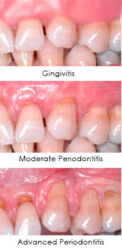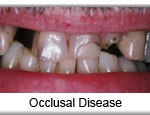Warning signs and treatments for gingivitis and periodontitis.
 Diseases of the gums and bone about the teeth are called “periodontal disease” in English. Gum disease encompasses a wide variety of conditions. Most commonly seen are gingivitis and periodontitis. Periodontal disease is a chronic bacterial infection that affects the gums and bone supporting the teeth. The disease may be limited to one tooth or all the teeth. The disease takes hold when bacterial plaque on the teeth causes the gums to be inflamed. Plaque is the sticky film that forms your teeth; it is like the glue that helps the bacteria stay on your teeth. Gingivitis is the mildest form of gum disease and is totally reversible with a professional dental cleaning and good home hygiene. Good home hygiene is not something people know how to do automatically. Most people need to be shown what to do to get the most benefit from their brushing. Even people who brush well can benefit from some coaching. Even the best sports athletes in the world have coaches. The dentist and dental hygienist are tooth brushing coaches.
Diseases of the gums and bone about the teeth are called “periodontal disease” in English. Gum disease encompasses a wide variety of conditions. Most commonly seen are gingivitis and periodontitis. Periodontal disease is a chronic bacterial infection that affects the gums and bone supporting the teeth. The disease may be limited to one tooth or all the teeth. The disease takes hold when bacterial plaque on the teeth causes the gums to be inflamed. Plaque is the sticky film that forms your teeth; it is like the glue that helps the bacteria stay on your teeth. Gingivitis is the mildest form of gum disease and is totally reversible with a professional dental cleaning and good home hygiene. Good home hygiene is not something people know how to do automatically. Most people need to be shown what to do to get the most benefit from their brushing. Even people who brush well can benefit from some coaching. Even the best sports athletes in the world have coaches. The dentist and dental hygienist are tooth brushing coaches.
Gingivitis that is left untreated can advance to periodontitis. This happens when bacterial plaque spreads below the gum line. Toxins in the plaque cause chronic irritation in the gums and bone starting an immune response. This immune reaction causes the gums and bone to break down and be destroyed. As the bone around the teeth is destroyed, the space between the gums and teeth deepens, and the disease progresses even faster with more destruction. The early stages of the disease often have mild symptoms, so many people are unaware of a serious problem developing and do not seek a dentist’s help. Signs of gum disease are:
- Bright red, swollen, or tender gums
- Bleeding gums (gums should not bleed when you brush or floss)
- Shrinking gums
- Loose teeth
- Pus from around the teeth
- Bad breath that does not go away
Change in the position of the teeth Though the main cause of the periodontal disease is bacterial plaque. Other factors make it more likely for you to get this disease. First and foremost is tobacco use. Smokers have more gum disease and are more likely to lose teeth. Moreover, they do not respond as well to treatments for gum disease. Smoking is also a risk factor for developing serious oral cancer, as well. Other risk factors for periodontal disease are family history, stress, medications, clenching and grinding, diabetes, poor nutrition, and various systemic diseases. Risk factors that increase the likelihood of getting gum disease have been known for a long time. However, in recent years, gum disease as a risk factor for other medical conditions has become clear. Recent research by Marjorie Jeffcoat, D.M.D., the dean of the University of Pennsylvania School of Dental Medicine, has shown that scaling and root planning resulted in an 84 percent reduction in women’s premature births who were less than 35 weeks pregnant.
Scaling and root planing are common gum procedures to clean the teeth above and below the gum line and pose no risk to the mother and unborn child. Premature birth is a significant problem in the United States, with nearly 12 percent of the babies being born preterm (before 37 weeks of pregnancy). Preterm birth results in increased death and other long-lasting problems for these babies. Before becoming pregnant, all women should seek a gum and tooth exam to avoid this serious complication of pregnancy. When gum disease is detected for women who are already pregnant, scaling and root planning can still help. This treatment should probably be carried out in the second trimester. Treatment for gum disease comprises many different modalities. Most common is scaling and root planning to clean the hard and soft deposits above and below the gum line. Simultaneously, the dentist may use various antimicrobial agents placed in the space between the gums and tooth to help fight the bacteria and improve the healing.
Various surgical therapies are often applied for patients whose periodontitis has altered the gums and bone too much. Depending on the disease’s nature, new bone and gums may be grafted in localized sites to improve the condition. For patients whose tooth-supporting bone loss is so great that they lose a tooth, dental implants may be an option to replace what they have lost. Some treatments for gums focus on cosmetics. These procedures are often called oral plastic surgery. Patients with a gummy smile (a display of too much gum when they smile) can help reshape the gums. Patients with an irregular line of gums or with gum recession on individual teeth can be helped with various techniques to restore missing gum tissue. This often has a cosmetic benefit and helps cover exposed root surfaces that are painfully sensitive to foods and cold liquids.
In conclusion, modern medicine has helped us all to come to expect an even longer life. Good dental care, which includes attention to the condition of the gums, is one important part. Regular tooth and gum check-ups can help prevent a wide variety of conditions and retain our teeth for long product life.
Dr. Cohen is an implant and cosmetic specialist. He has been practicing dentistry for almost twenty years and is the former Director of Dental Implantology at Lutheran Medical Center in Brooklyn, New York. A graduate of Columbia University’s School of Dental and Oral Surgery, he received training in advanced implantology from the prestigious Misch Implant Institute and at New York University’s College of Dentistry.
Greenwich Dentist – Greenwich Cosmetic Dentistry
Gerald Cohen, DDS
40 West Elm Street
Greenwich, CT 06830

